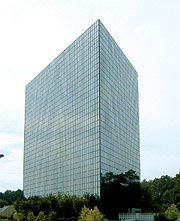
To comply with current ventilation codes, including minimum outside air requirements for increased occupancy, Highwoods had two options: follow ASHRAE 62's ventilation rate procedure or the recent interpretation of the standard's IAQ procedure. The latter "allows the use of any amount of outdoor air deemed necessary" if the designer can show that IAQ is acceptable to human occupants. If they chose to use the ventilation rate procedure, they would have needed to use 2,160 cfm of outside air for 108 people per floor, or 20 cfm of outside air per person per floor. But this method would have entailed extensive renovations, such as:
- Adding a new multizone, chilled water, constant-volume makeup air unit to the roof;
- Renovating the building's structure to handle the weight of the makeup air unit; and
- Installing new ductwork from the basement to the roof to accommodate more outside air.
Furthermore, bringing in more outside air would have negatively affected the building's IAQ. Because Century Center was located in a highly urbanized area, the air was full of gaseous contaminants, such as formaldehyde, ozone, nitrogen dioxide, and sulfur dioxide. As required by ASHRAE 62, Highwoods would have needed to reduce these gases to acceptable thresholds.
Referred to as the indirect solution, the ventilation rate procedure would have provided enough ventilation for the increased number of occupants in the building. However, this option would have only diluted the environment.
Keeping contaminants at ASHRAE-specific levels
Mechanical contractors from McKenney's Mechancial Contractors and Engineers handled the tenant upgrade. They sought a feasible, cost-effective way to avoid the significant capital costs and keep the gaseous contaminants at ASHRAE-specific levels. They asked Purafil to determine if the building qualified as an Enersave candidate.Purafil engineers accommodated the facility's current design by using the IAQ procedure to document that the building met IAQ requirements with its existing outside air rate. Instead of using more outside air, they enabled Highwoods to recirculate a larger portion of their supply air.
To comply with the filtration component of ASHRAE 62's IAQ procedure, Purafil replaced approximately 100 existing filters with 2-in. Purafilters in every floor's AHU. Each Purafilter consisted of two filtration layers: a MERV-8 particulate filter and Purafil CPS Blend media, a 50/50 volume blend of premium grade activated carbon and potassium permanganate-impregnated alumina to remove formaldehyde, ozone, nitrogen dioxide, sulfur dioxide, and a broad spectrum of other gaseous contaminants. By using Purafilters, Highwoods was able to eliminate the gases from Century Center's air instead of dilute them.
"The Purafilters were direct replacements for standard rock collectors, and they saved the customer a significant amount of money by avoiding the capital cost of ventilation upgrades," said McKenney's project engineer Mark Crane. "The energy savings from Enersave helped offset the cost of the filters."
Purafil also provided ongoing monitoring and reporting to ensure that Century Center remained in compliance with ASHRAE 62. Highwoods Properties was completely satisfied with the application of Enersave at Century Center. Using this energy-savings program, they saved a significant amount of money in capital equipment purchases and avoided major renovations to the facility. They also reduced the amount of outside air they needed to bring into the building, recirculated clean air, and removed gaseous contaminants. Highwoods renewed their contract at the end of the first year.
According to Crane, "Had the customer chosen to bring in more outside air, they would have had to spend money conditioning the additional air. Enersave was an attractive alternative to ASHRAE 62's ventilation rate procedure." ES
